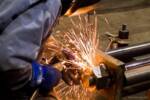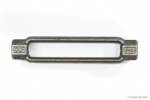Dane's FAQs
The answer can be found in AISC Design Guide 1,Section 2.11.3: “Anchor rod projections that are too short or too long must be investigated to determine if the correct anchor rods were installed. If the anchor rod is too short, the anchor rod may be projecting below the foundation. If the rod projection is too long,... Read more
Our two main concerns with providing galvanized bolts larger than 1-1/2” diameter with 8 threads per inch is the lack of overtap allowance standards for the mating nut and the potential for premature thread stripping due to the nut oversizing. Overtap Allowances All inch series hot dip galvanized hex nuts, regardless of grade, are tapped... Read more
The anchor rods in this photo were damaged because they were covered with snow and the equipment operator did not see them. Every situation is different, and we try to not make recommendations where bent anchors are concerned as we feel it is a question better answered by the project engineer, as he/she will be... Read more
ASTM A588 is a common steel standard that covers high strength, low-alloy structural steel shapes, plates, and bars with improved atmospheric corrosion resistance that is intended for riveted, bolted, or welded construction. Fasteners are not specifically included in the scope of A588, but that doesn’t stop engineers and contractors from asking for A588 bolts. Why is... Read more
ASTM A572 is a common structural steel standard that covers five grades (42, 50, 55, 60, 65) of high strength, low-alloy structural steel shapes, plates, and bars that is intended for riveted, bolted, or welded construction. Fasteners are not specifically included in the scope of A572, but that doesn’t stop engineers and contractors from asking for... Read more
ASTM A36 is a very common steel standard that covers structural carbon steel shapes, plates and bars. Fasteners are not specifically included in the scope of A36, but that doesn’t stop engineers and contractors from asking for A36 bolts. Why is that an issue? The inherent problem with trying to order bolts to a ASTM... Read more
Both ASTM F568M and ISO 898-1 outline several grades of metric fastener, from low carbon/low strength, up to high strength/heat treated alloy grades. The equivalents listed below should be only considered as rough equivalents. Special care should be taken before substituting grades to make sure that an acceptable substitute is being used. For example, grade... Read more
Many grades of bolt gain their strength though a heat treating process, and the addition of heat during welding can adversely alter those strength properties. However, some lower strength grades are easily weldable when manufactured from weldable steel. In general, steel items which have been heat treated for strength should generally not be welded since... Read more

You are correct that your capacity would be limited by the safe working load of the turnbuckle, but it would be limited to that regardless of the grade of steel used for the bracing rod. Let’s assume you are using mild steel, A307/A36 rods. The minimum yield strength of that material is 36,000 psi. Using... Read more

Yes, in some cases the stacking of F436 washers seems to be allowed, but not in all cases. The Research Council on Structural Connections (RCSC) in Specification for Structural Joints Using High-Strength Bolts, December 31, 2009, page 16.2-12 says, “If necessary, the next increment of bolt length can be specified with ASTM F436 washers in... Read more

